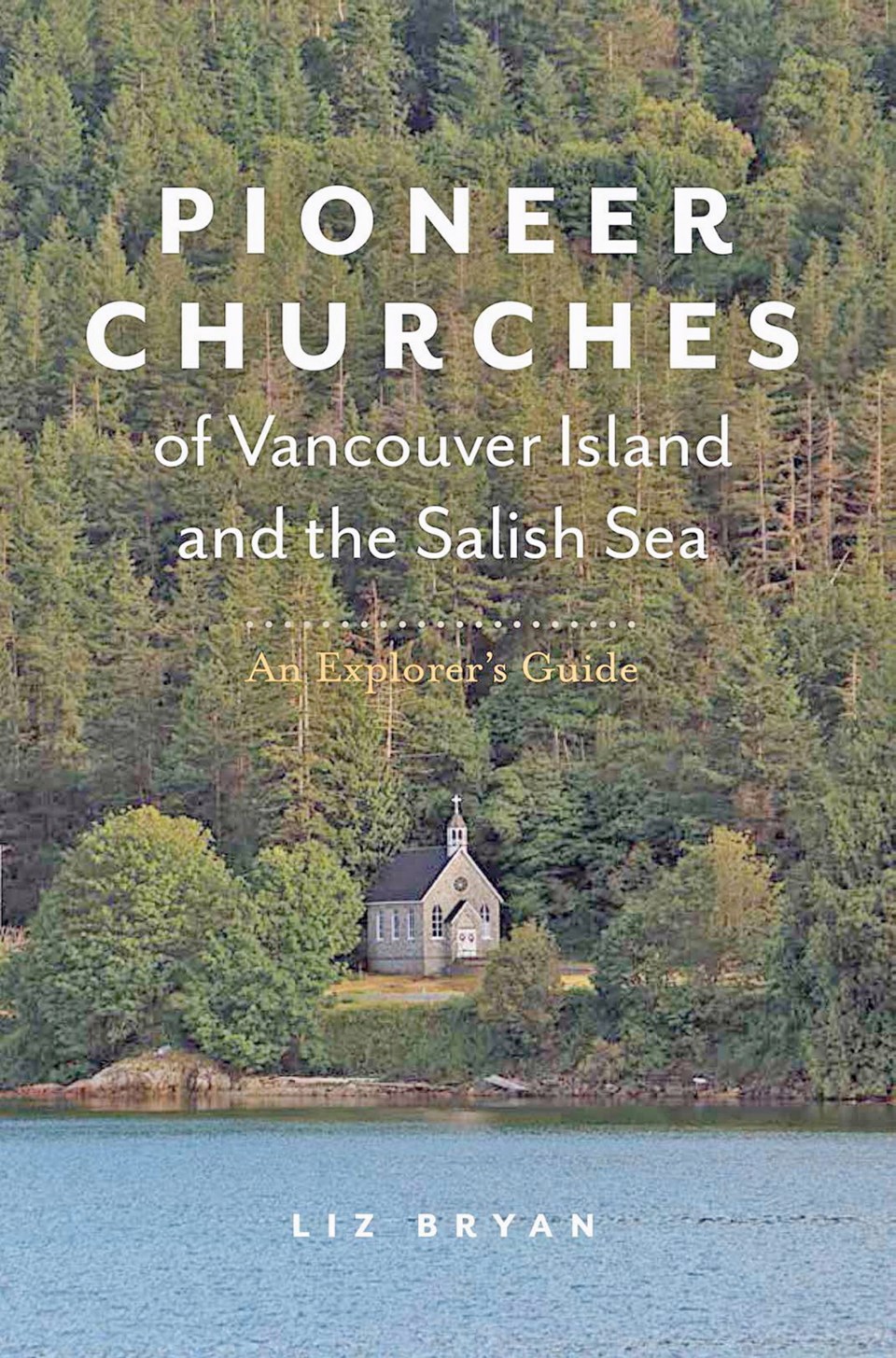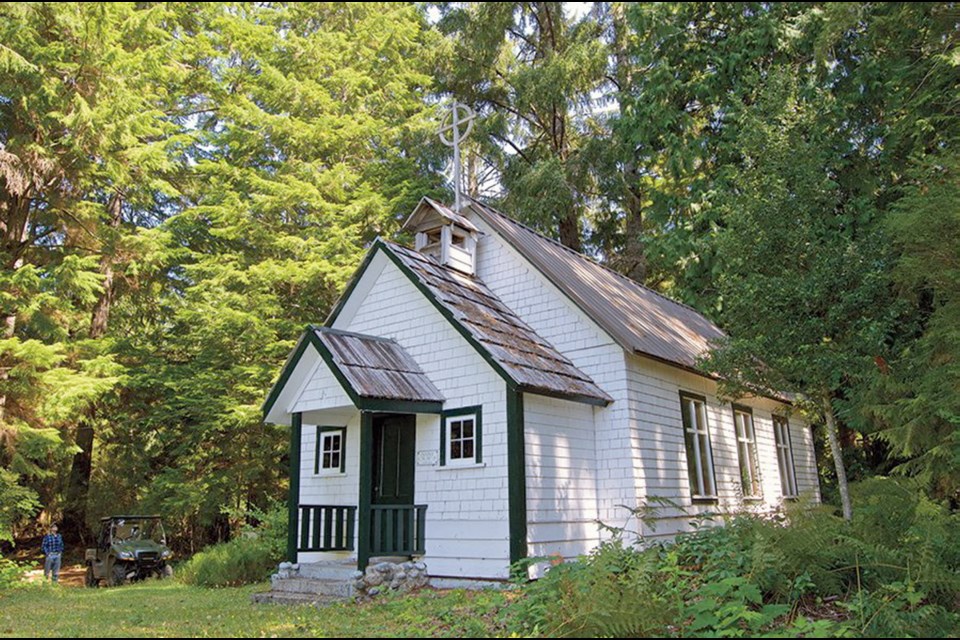Pioneer Churches of Vancouver Island and the Salish Sea: An Explorer’s Guide by Liz Bryan, Heritage House.
Founded by Norwegian and Swedish settlers, the rustic beauty of St. Olaf’s Church in Quatsino is highlighted in this excerpt from Pioneer Churches of Vancouver Island and the Salish Sea: An Explorer’s Guide, by Liz Bryan. The book contains profiles of 46 historic churches scattered throughout the Island from the Victoria-Nanaimo corridor to remote areas of the west coast and North Island.
Not many are left of the small immigrant settlements that once huddled along protected inlets on the stormy west coast of Vancouver Island. Many were quickly abandoned: the life was just too hard, the loneliness overwhelming, the weather mostly atrocious. There was no way out, except for a dangerous journey through a trackless forest or across a hostile ocean, with treachery at every turn from hidden rocks and reefs. Supply ships and the mail came irregularly from Victoria, if they came at all. The settlements that remain all have stories to tell, but few of them still have an old and viable church.
Quatsino is a small community tucked into Bergh Cove, near the head of Quatsino Inlet and many kilometres from the Pacific Ocean. It was settled by families from Norway and Sweden who had first tried homesteading in North Dakota, where the land was flat and very dry. They had heard of an alternative. At Chicago’s World’s Columbian Exposition of 1893, the sa���ʴ�ý government, eager for new colonists, was promoting free Crown grants of land along the west coast, which, the Scandinavians were told, had a climate and landscape similar to the fjords of their homeland. They were quick to uproot. In 1894, they arrived in Victoria and chartered the steamship Mischief, heading first to the settlement of Coal Harbour, where they overwintered in the cabins of an abandoned coal mine. They were a group of 11 men, only two of whom were bachelors; the rest came with wives and families and all their household goods.
The following spring, having scouted the area for possibilities, they settled for land near the head of Quatsino Sound. Chris Nordstrom, one of the leaders of the group, made a trip back to Victoria to obtain a Crown grant, and soon the site was surveyed, lots chosen, land cleared, and houses built. The group numbered about 30, and 19 80-acre properties were surveyed.
The new settlers were not all farmers and fishermen. In 1897, three of them located copper deposits high on the mountain above the sound. They built a trail, horses hauled up machinery, a Pelton wheel was rigged on a nearby creek for power, and a 245-metre tunnel was bored into the rock. Three shipments of copper ore were sent to a smelter in Tacoma, Washington, before the creek dried up a couple of years later and the project had to be abandoned.
 Part of the incentive the sa���ʴ�ý government offered to new settlements was funding for a school, provided there were more than 15 children. Luckily, Quatsino had 17. In 1898, an acre of waterfront on a bluff overlooking the cove was purchased by the community from Halvor Bergh, and the government gave $400 for the school building and furnishings. Under Bergh’s supervision, settlers went to work, cutting and squaring logs from the surrounding forest. The simple, single-storey rectangular building with a gable roof was a typical one-room schoolhouse. The sheathing was of fir siding shipped from Chemainus, the roof was covered with hand-split cedar shakes, and there was a porch and six large windows. Over the years, the building was put to other good uses for community meetings and dances — but also for church services, whenever a minister could visit.
Part of the incentive the sa���ʴ�ý government offered to new settlements was funding for a school, provided there were more than 15 children. Luckily, Quatsino had 17. In 1898, an acre of waterfront on a bluff overlooking the cove was purchased by the community from Halvor Bergh, and the government gave $400 for the school building and furnishings. Under Bergh’s supervision, settlers went to work, cutting and squaring logs from the surrounding forest. The simple, single-storey rectangular building with a gable roof was a typical one-room schoolhouse. The sheathing was of fir siding shipped from Chemainus, the roof was covered with hand-split cedar shakes, and there was a porch and six large windows. Over the years, the building was put to other good uses for community meetings and dances — but also for church services, whenever a minister could visit.
Quatsino grew. Soon it had a small wharf, a post office, a sawmill, a general store, and monthly freight service from Victoria. This was one community that was not going to quit. Its population continued to expand as fishing, logging, and mining began in the area, and the schoolhouse began to burst at the seams — at one time, 36 students were crowded in. A new school was built, and in 1937, the old log building was sold to the Anglican Church and named for St. Olaf, one of the Scandinavian saints. A tiny bell tower with a ringed cross was added to the roof. Pews and an altar were made, and services were soon being held, though there was never a resident vicar; a minister from St. Paul’s Church in Port Alice made the long boat trip up Neroutsos and Quatsino Inlets. Rev. Charles Lomas took over the parish in 1952 and came every Sunday from Port Alice until his death in 1991.
St. Olaf’s, in one of the oldest buildings on north Vancouver Island, is still in use for weddings, christenings, and other special events. It sits high on a wooded lot, where it peers down onto Bergh Cove through a fringe of cedars. Restoration work in 1985 provided concrete foundations, an additional small porch roofed with hand-split cedar shakes, a steel roof, and new handmade pews. The community did not have electricity until 1975. Old gas lights still hang from the church ceiling, and candles in iron wall brackets (for a long time the only source of light) are still used for special services. On the altar are two brass candlesticks, said to have been brought from Russia by a soldier who picked them up from the ruins of a war-torn village, and a small budding cross, given in memory of young William McCraghey, who was killed in a logging accident. The oldest item inside the church is an 1870s pump organ, which was given by a family in Port Alice —presumably it travelled to Quatsino along with the visiting minister. The front and sides of the church are covered with wooden shingles painted white, but at the back, the original logs underneath — cut, squared and dovetailed at the corners by the 1898 pioneers — can still be seen.
St. Olaf’s Church is most easily reached from Coal Harbour, a small hamlet fifteen minutes by paved road from Port Hardy. Coal Harbour is on Holberg Inlet, a body of water that is almost landlocked except for a very narrow channel connecting it to Quatsino Inlet, a long stretch reaching across the Island to the west coast. It is through this skinny little gap connecting the two inlets that a boat from Coal Harbour can reach Quatsino hamlet on Bergh Cove in about 20 minutes. It is the route the first settlers must have used.
On Mondays and Thursdays, a small launch delivers the mail to Quatsino (now known locally as Old Quatsino). If you are at the end of the Coal Harbour dock by 1 p.m., you may be able to accompany the mail on its journey — if there is room on the boat and the skipper agrees to take you. The fee is $20 each way. The mail boat stays at the dock only a short while, barely enough time to scurry up the hill for a quick visit to the church. A more expensive return journey by water taxi will provide more time to explore the church, the cemetery, the “new” school (which is also a heritage building), and the Quatsino community museum. The church is always open.
Visitors can contact the Quatsino Museum and Archives by phone at (250) 949-7960 or email at [email protected] for more information when planning to visit the church. Visit



